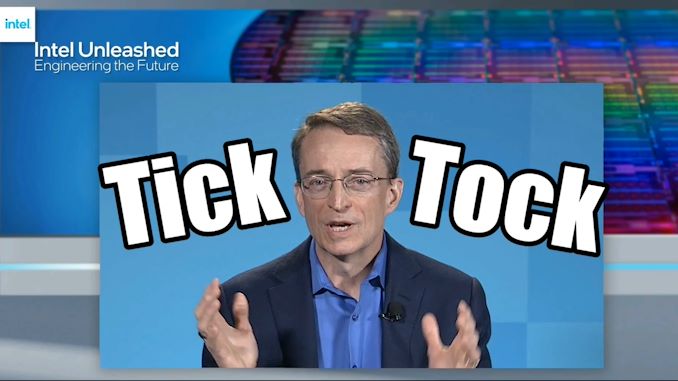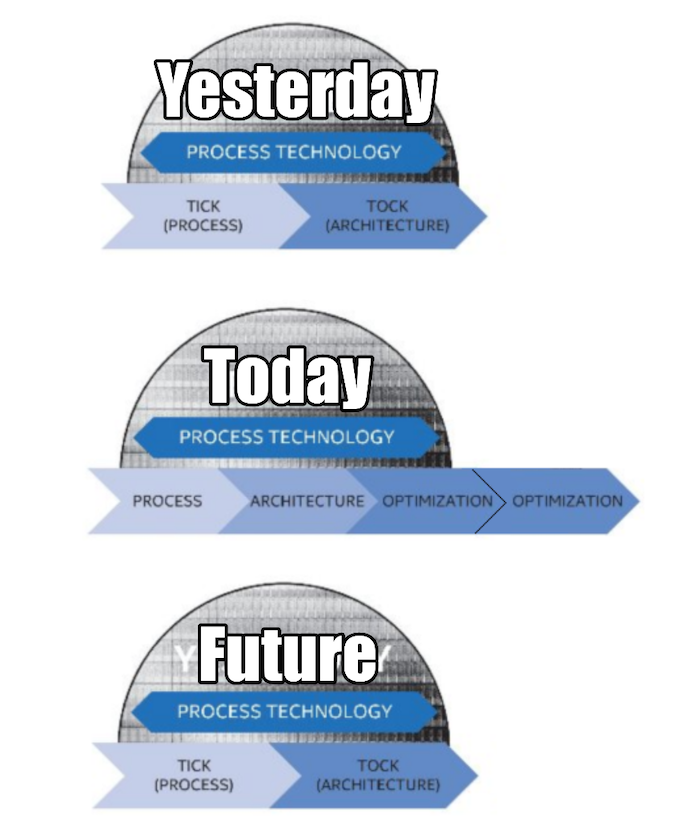Intel to Revive ‘Tick-Tock’ Model, Unquestioned CPU Leadership Performance in 2024/2025
by Dr. Ian Cutress on March 23, 2021 6:31 PM EST- Posted in
- CPUs
- Intel
- Tick-Tock
- 7nm
- Chiplets
- Pat Gelsinger
- Meteor Lake
- Tiles

As part of today’s announcements, during Intel’s Q&A session after the prepared remarks, CEO Pat Gelsinger explained how Intel is going to revive its fortunes when it comes to its leading edge compute products. One of Gelsinger’s mantras seems to be that unquestioned leadership products bring unquestioned leadership margins for those products, and for Intel to execute, it needs to return to its days of old.
In the past, through the 1990s, 2000s, and into the 2010s, Intel’s manufacturing philosophy was known as ‘Tick-Tock’. This means that for every product generation, the leading edge compute hardware was either a Tick (process node enhancement), or a Tock (microarchitecture enhancement). Each generation would alternate between the two, allowing Intel to take advantage of a familiar design on a new process node, or using a mature node to enable a new performance-focused design. That policy was scuppered when delays to Intel’s 10nm forced Intel into more of a Tick-Tock-Optimization-Optimization-Optimization model.
Today CEO Pat Gelsinger stated that at Intel’s core it has to re-establish the Tick-Tock model that enabled repeated leadership in the CPU ecosystem, buoyed by a healthy CPU roadmap. Part of this is re-establishing discipline in Intel’s ranks to continually provide both microarchitecture updates and process node updates on a regular expected cadence. Pat stated as part of the call that Intel will look towards a confirmed yearly process node improvement, and as a result, there might be a lot of Ticks in the future, with a push to more Tocks as well.
On top of this commentary, Pat Gelsinger also stated that Intel’s CPU roadmaps are already baked in through 2021, 2022, and 2023. The company is thus looking to 2024/2025 for ‘unquestioned CPU leadership performance’, which traditionally means the fastest processor for single thread and multi-thread workloads. This is for sure a laudable goal, however Intel will also have to adapt to a changing landscape of chiplet processor designs (coming in 2023), enhancing on-die accelerators (GNA already present), and also what it means to have leadership performance – in the modern era, leadership performance doesn’t mean much if you’re also pushing lots of Watts. Intel stated that its 7nm process is now comfortably on track to deliver Meteor Lake, a client CPU using tiles/chiplets, in 2023, however we are likely looking to a 7nm variant or even external processes for a 2024/2025 product. Intel has also stated that it is looking to consider the core of its leading edge compute on external foundry processes, although one might argue that this doesn’t explicitly say ‘CPU’.
It is also worth noting that Intel/Gelsinger isn’t calling its disaggregated silicon as ‘chiplets’, and prefers to use the term ‘tiles’. This is because Intel’s tiles amount to long wires across 3D packaging technologies like EMIB and Foveros, compared to package-based multi-die interconnect that require buffers as well as control fabric. Tiles by this definition are more costly to implement than chiplets, and have additional thermal considerations by having high-powered silicon close together, so it will be interesting to see how Intel balances these new packaging technologies with the more cost-sensitive elements of its portfolio, such as client processors.
It’s been known that Intel’s microarchitecture teams haven’t been idle waiting for 10nm to come through the pipe, with a number of designs ready and waiting to go for when the process node technology matures. With any luck, if Intel can get a headwind with 7nm, when 2024 rolls around it might all come thick and fast.











109 Comments
View All Comments
Colin1497 - Tuesday, March 23, 2021 - link
Tick Tock doesn't really date back to the 1990s.quorm - Tuesday, March 23, 2021 - link
Yeah, didn't it start around the same time as "core" ?DigitalFreak - Tuesday, March 23, 2021 - link
2007, so roughly a year before Nehalem launched.GeoffreyA - Wednesday, March 24, 2021 - link
Not in terminology or exact philosophy, but the idea crudely existed back then. The Pentium, starting off at 0.8 um, was produced on a range of processes, probably 0.35 um being the most common. Pentium Pro on both 0.35 and 0.5 um. By the Pentium II's time it was starting to be differentiated better: Klamath, carrying the older process, was 0.35 and Deschutes 0.25 um. Pentium III Katmai started off at 0.25 and Coppermine shrunk that to 0.18 um.Pentium 4 Willamette took off at 0.18 um/180 nm, and Northwood went down to 130. Prescott, notably, alterered both microarchitecture and process (90 nm), but Cedar Mill was just a 65 nm die shrink; and Conroe, coming out shortly afterwards, launched at 65 nm.
Spunjji - Friday, March 26, 2021 - link
"Prescott, notably, alterered both microarchitecture and process"Notably indeed :D
GeoffreyA - Friday, March 26, 2021 - link
And now, the venerable Prescott passes on its (heated) baton to the Lake Rocket.taz-nz - Saturday, April 3, 2021 - link
Prescott was a giant band aid fix to the Pentium 4 choking due to lack of FSB & Memory bandwidth as core clock speeds rose. Intel just piled on a tons of cache memory hoping it would hid the issue without have to engineer a new chipset with a higher bus speed.I had a Pentium 4 HT 3.0 at the time, and sold it a purchased a Pentium 4 HT 2.8C and matched it with Corsair Dominator 2 1066 memory, I overclocked the FSB to 1066MT/s from 800MT/s and lower the CPU multiplier from 14x to 13x, giving me a clock speed just under 3.5ghz , my flat mate at the time had a Pentium 4 HT 560 (Prescott 3.6ghz) my system was much faster than his, despite his CPU have twice the cache memory and nearly a 150hz clock speed advantage.
The band aid didn't work, the CPU ended up almost 50% cache memory by die size, which cranked the power consumption and heat output to 11. The real fix was to get rid of the system bottle neck.
Techie2 - Tuesday, March 23, 2021 - link
Even if Intel was able to become the CPU performance leader I'd never allow the purchase of any of their products by our company due to Intel's documented history of crime and anti-trust law violations in their efforts to prevent a free, level marketplace for consumers. Intel's evil management mentality almost eliminated AMD and choice for all consumers. Intel could not pay me enough to use their products and they certainly don't deserve my business. Voting with you wallet can prevent exploitation.Kamen Rider Blade - Tuesday, March 23, 2021 - link
I'm with you, I'll never purchase a CPU from the convicted monopolist known to Lie/Cheat/Steal ever again.timecop1818 - Tuesday, March 23, 2021 - link
that's like saying "i don't want to live in usa because half the states legalized weed". continue buying your underperforming Chinese-built AMD while I stick to quality Intel.